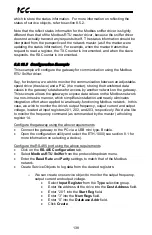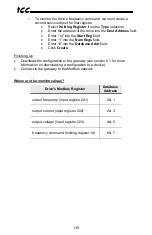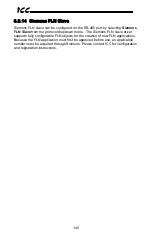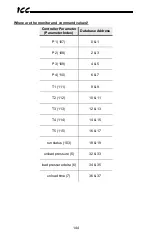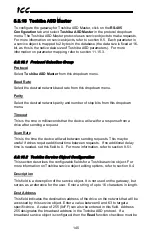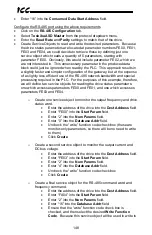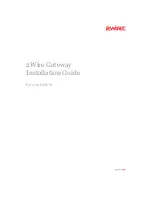
138
ICC
which to store the status information. For more information on reflecting the
status of service objects, refer to section 8.5.2.
Note that the reflect status information for the Modbus sniffer driver is slightly
different than that of the Modbus RTU master driver, because the sniffer driver
does not actually transmit any requests itself. The status information should be
interpreted from the perspective of the network master (as if the master were
updating the status information). For example, when the master transmits a
request to read a register, the TX Counter is incremented, and when the slave
responds, the RX Counter is incremented.
8.8.13.3
Configuration Example
This example will configure the gateway for communication using the Modbus
RTU Sniffer driver.
Say, for instance, we wish to monitor the communication between an adjustable-
speed drive (the slave) and a PLC (the master), storing the transferred data
values in the gateway’s database for access by another network on the gateway.
This scenario allows the gateway to expose data values on the Modbus network
in a non-intrusive manner, which simplifies installation and nearly eliminates
integration effort when applied to an already-functioning Modbus network. In this
case, we wish to monitor the drive’s output frequency, output current and output
voltage, located at input registers 201, 202, and 203, respectively. We’d also like
to monitor the frequency command (as commanded by the master) at holding
register 14.
Configure the gateway using the above requirements
•
Connect the gateway to the PC via a USB mini type-B cable.
•
Open the configuration utility and select the ETH-1000 (see section 8.1 for
more information on selecting a device).
Configure the RS-485 port using the above requirements
•
Click on the
RS-485 Configuration
tab.
•
Select
Modbus RTU Sniffer
from the protocol dropdown menu.
•
Enter the
Baud Rate
and
Parity
settings to match that of the Modbus
network.
•
Create Service Objects to log data from the desired registers:
o
We can create one service object to monitor the output frequency,
output current and output voltage.
•
Select
Input Register
from the
Type
selection group.
•
Enter the address of the drive into the
Dest Address
field.
•
Enter “201” into the
Start Reg
field.
•
Enter “3” into the
Num Regs
field.
•
Enter “0” into the
Database Addr
field.
•
Click
Create
.















